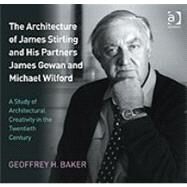The Architecture of James Stirling and His Partners James Gowan and Michael Wilford: A Study of Architectural Creativity in the Twentieth Century
, by Baker,Geoffrey H.- ISBN: 9781409409267 | 1409409260
- Cover: Hardcover
- Copyright: 8/28/2011
Sir James Stirling was arguably the greatest British architect of the twentieth century, and of comparable interest and stature to Sir Edwin Lutyens. This book provides the most comprehensive critical survey of Stirling's work to date, charting the development of his ideas during four turbulent architectural decades. It is divided into four chronological sections: his formative years; his partnership with James Gowan; his period in practice as sole partner; and finally, his partnership with Michael Wilford. Using archival material, extensive interviews with his partners and others who worked for him, together with analytical examination of key buildings, this detailed critical examination explains his philosophy, working method and design strategy. In doing so, it sheds new light on the atelier structure of his office and who did what on his major buildings. Discussions with James Gowan reveal the extent of the partners' research into architectural theory that made a major contribution to the design strategy at the Leicester University Engineering Building. These discussions also highlight differences in the personalities in the two men - where they were complimentary and where there was conflict. James Gowan also explains why the partnership ended. Michael Wilford discusses his role during his long association with Stirling and Leon Krier provides his own insight into Stirling's idiosyncratic character. Geoffrey Baker is the first to analyse in depth the articulation systems used in major projects undertaken by Stirling and confirms that the State Gallery and Chamber Theatre at Stuttgart is not a demonstration of Stirling's interest in post-modernism, but an example of his growing allegiance to the classical canon in architecture. In addition to providing the first major documentation of this, it highlights in particular Stirling's debt to Karl Friedrich Schinkel, the distinguished German neo-classicist. In a discussion of his mature works, including the Performing Arts Center at Cornell University, the Wissenschaftszentrum in Berlin and the Headquarters of Braun A G at Melsungen, Baker explains how his work can be understood in terms of several interconnected ideas. These include surrealism, historicism, myth and metaphor, inconsistency and ambiguity, bi-lateral symmetry, the garden, rusticity and arcadia, and the archetype, seen as the repository of the collective architectural memory. As well as discussing his interests and those who influenced Stirling, the book compares his oeuvre with that of the pioneers of modern architecture, Mies van de Rohe, Frank Lloyd Wright, Alvar Aalto and Le Corbusier. Overall, this book stresses how James Stirling saw the inadequacies of modern architecture. It argues that,to combat this, he made a serious attempt to align his output with the architectural continuum. It shows how the influence of the Pantheon, the great Italian architects of the Renaissance and their Mannerist successors and the rich architectural heritage of Britain can all be detected in his work. In particular, Stirling was influenced by important British architects, including Soane, Hawksmoor, Vanbrugh and Lutyens. Unlike most architects, James Stirling advocated an inclusive architecture that combined abstraction and the representational, the formal and the informal, traditional and high tech. Like his eclectic predecessors of the nineteenth century, he addressed the emotional realm of architecture with works that resonate with recollections of other periods, even other countries. Stirling's oeuvre chart a remarkable career, with major works that will continue to grow in importance as will his own reputation. He was always convinced that he had special gifts; he was charismatic, irreverent, courageous, serious; he could be rude, was stubborn, belligerent, gentle, witty, mischievous and cunning; he was endlessly inventive and deeply dedicated to his art, producing buildings that reflect







